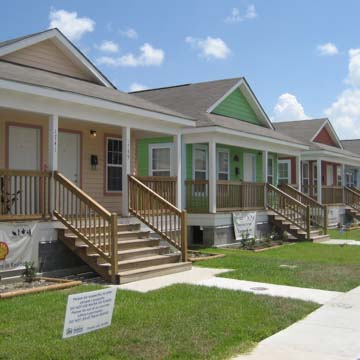This post–Hurricane Katrina project conceived by New Orleans musicians Branford Marsalis and vocalist Harry Connick Jr. is a residential community planned to provide housing and encourage the return of musicians to New Orleans after Katrina. The area was heavily flooded after the levees failed in the aftermath of the hurricane’s landing. The New Orleans Area Habitat for Humanity built sixty-nine single-family one-story houses, raised on concrete-block piers, with hipped or gabled roofs, front galleries or porches, and front lawns. The houses are painted in various bright pastel colors, creating a lively streetscape. This is their most notable characteristic, since architecturally they are examples of New Orleans vernacular houses. The community is anchored by the Ellis Marsalis Center for Music (2007–2008, Mathes Brierre) a two-story building at the intersection of N. Prieur and Bartholomew streets that is named for the Marsalis patriarch. The center provides class and practice rooms, a performance hall, meeting rooms, and a courtyard. Opposite is a children’s playground.
Nearby at 3811 N. Galvez Street is William Frantz School (1937, E. A. Christy), a three-story building with Art Deco detailing around the entrance that was renovated and given a large modern addition by Billes Partners in 2013. In November 1960, six-year-old Ruby Bridges attended the all-white school, one of four black students to integrate New Orleans’s public schools; the other three girls went to McDonogh School No. 19 (1929, E. A. Christy; 5909 St. Claude Avenue), closed since Hurricane Katrina.















